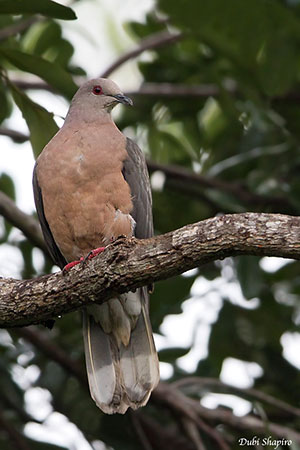
The female resembles male, but she has back, scapulars and wing-coverts washed olive or brown. The underparts are more vinaceous and the hindneck is duller.
The juvenile has grey head and neck washed brown. On the underparts, foreneck and breast are greyish-brown, whereas belly is fawn or cinnamon.
RANGE:
The Ring-tailed Pigeon is found only in Jamaica.
HABITAT:
The Ring-tailed Pigeon frequents mainly primary montane and lowland forests between 150 and 2,000 metres of elevation. It can be seen in secondary growths, clearing borders, cultivated areas and even gardens.
CALLS AND SONGS: SOUNDS BY XENO-CANTO
The Ring-tailed Pigeon gives a soft series of 4-5 notes “caaaooo…caaoo…caoooo…caooo”. Each note is short and quickly repeated. The last syllable is louder and more emphatic.
The call is a throaty “cru-cru-crooooo” with lower last note.
BEHAVIOUR IN THE WILD:
The Ring-tailed Pigeon is exclusively arboreal. It feeds on a variety of fruits and seeds from several plant species including mistletoe, Ficus and Laurus species. It also consumes the fruits of the Jamaican sweetwood tree (Nectandra antillana).
Both the bird and the tree have a close relationship, known as mutualism or interspecific cooperation. Each species depends on the other for life. The tree provides food to the bird, and the bird disperses the seeds of this tree.
The Ring-tailed Pigeon usually moves in groups. Large flocks usually gather at fruiting trees but also in a roost at night.
This species breeds in the highlands in spring and summer. The nest is a typical platform of twigs placed at tree top. The courtship behaviour is currently unknown.
The Ring-tailed Pigeon may perform altitudinal movements. It descends from mountains to lower elevations (150-300 metres) outside breeding season.
The flight is fast and powerful, with active wingbeats interspersed with glides.
REPRODUCTION OF THIS SPECIES:
The breeding season takes place in spring and summer, between February and August.
The Ring-tailed Pigeon builds a platform with twigs, lined with leaves and pieces of bark. It is well-hidden in the dense foliage of a tall tree in the forest. It is usually placed at tree top.
The female lays 2 white eggs. No other information.
PROTECTION / THREATS / STATUS:
The Ring-tailed Pigeon is heavily threatened by hunting and degradation or destruction of the habitat, through forest clearance and fragmentation. In spite of protection, much illegal hunting still continues, like habitat loss and probably illegal trade. Hurricane effects are also an important threat as they destroy the fruiting trees providing food to this species.
The population is roughly estimated to number 3,500/15,000 individuals and is probably declining.
The Ring-tailed Pigeon is currently classified as Vulnerable.
Fr: Pigeon de la Jamaïque
Ang: Ring-tailed Pigeon
All: Karibentaube
Esp: Paloma Jamaicana
Ita: Piccione codabarrata
Nd: Jamaicaduif
Sd: jamaicaduva
Photographer:
Dubi Shapiro
Dubi Shapiro Photo Galleries & Dubi Shapiro's Pictures on IBC
Text by Nicole Bouglouan
Sources:
HANDBOOK OF THE BIRDS OF THE WORLD vol 4 by Josep del Hoyo-Andrew Elliott-Jordi Sargatal - Lynx Edicions - ISBN: 8487334229
PIGEONS AND DOVES by David Gibbs, Eustace Barnes and John Cox - Pica Press Sussex - ISBN: 1873403607
BIRDS OF THE WEST INDIES – by Herbert Raffaele, Kristin Williams et Tracy Pedersen – Helm – ISBN: 9780713649055
Endangered Wildlife and Plants of the World, Volume 8 by Marshall Cavendish Corporation – Editor: Marshall Cavendish, 2001 – ISBN: 0761472029, 9780761472025 - 1872 pages
Avibase (Denis Lepage)
Neotropical Birds – Cornell Lab of Ornithology
Ring-tailed Pigeon
Patagioenas caribaea
Columbiformes Order – Columbidae Family
INTRODUCTION:
The Ring-tailed Pigeon is endemic to Jamaica where it frequents forested areas in hills and mountains.
It feeds on fruits and seeds and forages in the canopy, often in small flocks. It nests in a platform of twigs well-hidden among thick foliage high in tree.
The Ring-tailed Pigeon is heavily threatened by hunting pressure and destruction of the habitat. The species is currently classified as Vulnerable.
DESCRIPTION OF THE BIRD:
Biometrics:
Length: M: 38-48 cm – F: 38-43 cm
Weight: 250 g
The Ring-tailed Pigeon adult male has brownish-grey upperparts. The hindneck is green to bronze with metallic gloss. On the upperwings, wing-coverts are brown and flight-feathers are blackish-brown. On the uppertail, the base is grey whereas the terminal portion is brownish-grey. They are separated by a dark grey band giving the bird its name.
Head, neck and underparts are dull vinaceous with pink tinge on underparts. The undertail-coverts are brownish-white. The underwings are pale grey.
The bill is black, including the cere. The eyes are orange with reddish orbital skin. Legs and feet are red.
